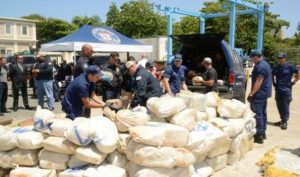 Is the US Government restarting the War on Drugs? I can’t answer that, but the signs seem ominous.
Is the US Government restarting the War on Drugs? I can’t answer that, but the signs seem ominous.
We’ve all heard about Attorney General Sessions’ dislike for marijuana and contempt for those who use it. That’s no secret. Now we’re seeing changes at the Office of National Drug Control Policy.
I know Kellyanne Conway only from TV, but a quick check portrays her background as “pollster, political consultant, and pundit.” No evidence of training or expertise in dealing with drug epidemics. The article goes on to hint at major budget cuts for ONCDP, the sort that could mean the Office is on the way down– or perhaps, out.
Now we have Jim Carroll, a White House deputy chief of staff, to be nominated as the latest drug czar. Carroll formerly served as general counsel for the Office of Management and Budget.
Apparently both DOJ and HHS are preparing their own separate strategies for next year’s efforts to combat drug abuse. ONDCP was created to replace such separate campaigns with a more uniform strategy. In the past, drug intervention efforts had suffered from the usual bureaucratic snafus: Duplication, political influence, and of course, pork.
Personally, I thought the Christie-led expert panel came up with a reasonably good set of recommendations, and like most people in the field, I was puzzled by lack of follow thru. Now I see those panel members are being “replaced” by politicos. I’m wondering if that was simply because the White House had already decided to go in an entirely different direction– re-emphasizing enforcement and de-emphasizing treatment and recovery. That’s what we saw from the original Reagan-era approach, popularly called the “War on Drugs“.
If you recall, and I bet you do, the focus was on early childhood prevention programs and an aggressive arrest and incarceration policy for drug offenders. Much of this was conceived in the wake of that massive cocaine/ crack epidemic.
Circumstances were different then, of course. Cocaine wasn’t grown in the US so had to be smuggled in. Nowadays in addition to heroin from Mexico and Afghanistan, we also get plenty of prescription opioids via our own pharmaceutical industry. Then there’s the illicitly-made fentanyl that’s driving our current OD fatality crisis. and can be purchased over the Internet without much difficulty. It’s cheap and easy to make and generates a healthy profit margin, both on its own and as a hidden additive for other drugs.
It occurs to me that even if we could completely close the nation’s borders to drug traffic, the incentives are already in place for a quick ramp-up of domestic production. It’s not that difficult and the dealers will be clamoring for it. Money to be made.
About elementary school prevention programs: those are fine for awareness but not terribly effective in reducing later drug use. Whatever impact they have at age 7 or 8 appears to have largely disappeared by 13 or 14, the prime years for experimentation.
Point is, if this type of strategy didn’t succeed 30 years ago, what makes us think it’ll be a success this time around?
See, the thing about drug epidemics is that once you declare war on them, it’s only a matter of time until you begin to realize, reluctantly, that many of the people you’re battling are your children and those of your neighbors. That’s why ultimately, treatment and recovery work better than punishment and deterrence.
It’s a lesson I thought we’d already learned.










